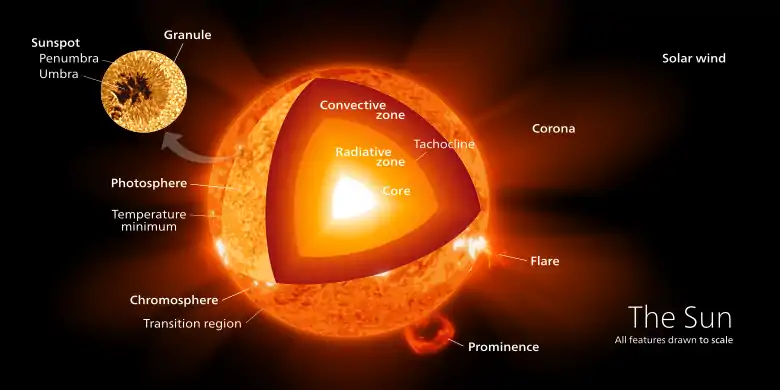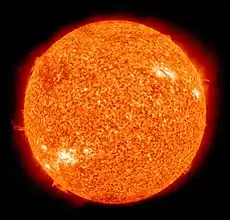Granule (solar physics)
Granules on the photosphere of the Sun are caused by convection currents (thermal columns, Bénard cells) of plasma within the Sun's convective zone. The grainy appearance of the solar photosphere is produced by the tops of these convective cells and is called granulation.
_as_of_January_20%252C_2020.jpg.webp)

The rising part of the granules is located in the center where the plasma is hotter. The outer edge of the granules is darker due to the cooler descending plasma. (The terms darker and cooler are strictly by comparison to the brighter, hotter plasma. Since luminosity increases with the fourth power of temperature, even a small loss of heat produces a large luminosity contrast; this "cooler", "darker" plasma is still far hotter and vastly brighter than a thermite reaction.) In addition to the visible appearance, which would be explained by convective motion, Doppler shift measurements of the light from individual granules provides evidence for the convective nature of the granules.
A typical granule has a diameter on the order of 1,500 kilometres (930 mi)[1] and lasts 8 to 20 minutes before dissipating.[2] At any one time, the Sun's surface is covered by about 4 million granules. Below the photosphere is a layer of "supergranules" up to 30,000 kilometres (19,000 mi) in diameter with lifespans of up to 24 hours.
Gallery
 Detailed view of a sunspot and surrounding solar surface. The dense pattern of cells (unrelated to the sunspot) is granulation; the individual cells are granules.
Detailed view of a sunspot and surrounding solar surface. The dense pattern of cells (unrelated to the sunspot) is granulation; the individual cells are granules.
References
- Zirker, Jack B. (2003). Sunquakes: Probing the Interior of the Sun. Johns Hopkins University Press. p. 2. ISBN 0-8018-7419-X. OCLC 919928822.
- Bahng, J. & Schwarzschild, M. (September 1961). "Lifetime of Solar Granules". The Astrophysical Journal. 134: 312. Bibcode:1961ApJ...134..312B. doi:10.1086/147160.
